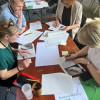Establishment and test of new Nordic textile recycling networks is among the next steps.
A new project report concludes that the Nordics have enough capacity in automated sorting and recycling to meet the upcoming volumes of recyclable textiles. This is based on estimating volumes of recyclables and comparing those volumes with current and upcoming sorting and recycling capacity. However, imbalances within individual countries highlights the need for further Nordic collaboration.
“In Sweden for example, there is an overcapacity for cotton recycling, but we lack the capacity for recycling polyester, which Norway, on the other hand, is building up. It is therefore important that we cooperate on sorting and recycling so that individual countries don’t make unnecessary investments", says Linea Kjellsdottor Ivert, Senior Researcher at VTI and project manager for SATIN.
"It is also important that we see the Nordics as a region and reduce unnecessary transport by exporting textiles abroad when they can be taken care of here", she continues.
The project has analyzed data from nine pilot studies of different collection solutions to study the advantages and disadvantages of the collection solutions.
Pre-sorting in Eastern Europe and back to the Nordics
Today, pre-sorting of textiles from the Nordic countries typically takes place in Eastern Europe. At the same time, the Nordic countries have invested enormously in automatic sorting facilities and recycling facilities. To minimize transportation and CO2 emissions, pre-sorting should also take place within the Nordics. However, optimizing pre-sorting requires further collaboration and knowledge sharing between different actors and countries within the Nordic region.
More effective collection methods and pre-sorting activities
The report concludes that there is a need for more effective collection methods making it easy for consumers to hand in their used textiles. The pre-sorting processes should also be more effective and economically feasible.
The report also points out a range of uncertainties related to pre-sorting activities. Are the consumers able to separate between what can be reused and what cannot be reused? Is it possible to use new technology to make pre-sorting activities more efficient? Is centralized or decentralized pre-sorting the best solution?
“It became clear that there is not one best solution rather that collection methods are appropriate to different degrees in different contexts. What applies generally, however, is that the consumer has an incredibly important role in the collection system. Quite a lot is demanded of the consumer today and it is not always clear what we should do to pass on our textiles. It must be easy to do the right thing”, says Linea Kjellsdottor Ivert.
The SATIN Project
The textile industry is among the most resource-consuming industries, with a vast environmental impact, still the circularity of textiles is low worldwide and in the Nordics. Over 50% of textiles in the Nordics could have been reused or recycled, however, they often end up in the residual waste and becomes incinerated. It is therefore important that the Nordic countries increase the collection and recycling rates, and reuse more locally.
The SATIN project seeks to create conditions for increased circularity of textiles in the Nordics. The purpose of the project has been to develop and test solutions that can address the challenges related to collection and sorting of textiles by looking at the supply chain management perspective.
The project ran from 2020 – 2022 and involved 24 organizations from Sweden, Norway, Denmark and Finland, and was led by the Swedish National Road and Transport Research Institute (VTI).
Read more about the SATIN project
Next step: new Nordic networks
The project group has applied to EU’s LIFE program based on the results from the project report. The aim of the application is to develop the project results into concrete research activities.
They will among other establish new Nordic textile recycling networks and develop solutions for handling recyclables to improve effectiveness. They will also investigate consumer collection practices to better understand how consumers can be involved in the collection phase. Finally, they will explore the possibility for online collection where consumers can return their textiles in the same way as they receive e-commers goods, such as home delivery.
Background
The SATIN project is a part of the Circular Business Models program which is one eight initiatives launched by the five Nordic Ministers of Trade and Industry.






